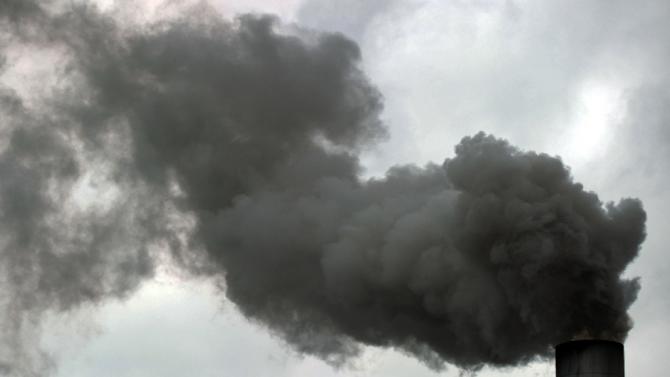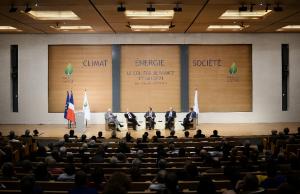Bill Nye brought science into kids’ lives and made us laugh. He inspires memes, has his own bow tie line and has appeared on numerous television shows, including, earlier this month, alongside Arnold Schwarzenegger, National Geographic Channel’s Explorer series. He’s even been a guest on Dancing With the Stars.
But under the stardust is a serious scientist who started life as a humble mechanical engineer at Boeing and is now on a mission to combat scientific ignorance and fight against climate change. His new book, Unstoppable: Harnessing Science To Change The World, mixes science and his trademark humor to rally a new “Greatest Generation”—ours—to solve a global climate change crisis that he believes is more threatening to our survival than World War Two.
Speaking from his home in Los Angeles, he recalls how he fought a good-natured “eco war” with his celebrity neighbour, Ed Begley Jr.; how climate change deniers can be defeated; and why the upcoming UN summit in Paris can be a turning point for our battle against global warming.
You started life as an engineer and are best known as The Science Guy. Can we engineer ourselves out of the global climate change crisis?
Absolutely! [Pause] Anything else? [Laughs]. There’s enough energy in most places—wind, solar, tidal and geothermal—to run the whole world. What we need is to DO IT. We need to get started. What we want to do is provide electricity, worldwide communication via the Internet, and clean water to everyone in the world. This is absolutely doable from an engineering standpoint. But to get it done in a timely fashion we have to enact a fee on carbon dioxide production and the release of methane. If we had this policy change, we could change the world.
You describe an epiphany in Beijing that focused your mind on climate change. Recall that moment for us.
The Planetary Society participated in the International Aeronautical Conference in Beijing a few years ago. I was talking physics and planetary science with a young guy and I said, “I really want to go to the famous Peking duck restaurant.” He said, “How do you want to get there, it takes a long time.” I asked if we could ride our bikes. It was only five or six miles away. So I borrowed his dad’s bike and rode down to the restaurant. The reason this bicycle, which was in beautiful shape, was available, was because his dad now had a car. He didn’t ride his bike to work anymore, which he had for 20 years of his professional life. I realized, there’s the change happening right there! This guy was living through the transition from bikes to cars and the 24/7 gridlock and pollution it brings with it.
Developing countries like China or India want all the benefits of modern life. Surely, we don’t have the right to prevent them from enjoying the kind of energy intensive lives we have had for so long?
It’s not about “right.” What we want to do in engineering terms is give them a higher quality of life than we have in the developed world by using less energy; to do more with less. This is in everyone’s best interest. We want the developing world to skip the fossil fuel/carbon dioxide/ methane-producing step and go right to renewable energy, so they won’t have to go back and clean up the environment they will have destroyed or degraded because of fossil fuels.
You call your home in Los Angeles “Nye Labs.” Tell us about the innovations you have introduced and your good-natured “eco-war” with your neighbor, the actor Ed Begley Jr.
Until a few weeks ago, he lived three doors down the street from me. He had nine kilowatts of solar panels on his house. I had four. The reason I had four was that a different neighbor’s house blocked the sun at certain times of the day. I’ve thought about cutting that part of her house down [laughs] but it probably wouldn’t be the most neighborly thing.
I have as many conventional photovoltaic panels as my roof will allow, given the sun conditions in the city. This lowers my electric bill to about $10 every 60 days. And because I make more energy than I use I earn credits for that spare energy. I also have a solar hot water system. This is not rocket science, as I like to say. It’s just plumbing.
Begley had a hot water system, which I didn’t think was all that good. Mine’s better than his was. [Laughs] The other big investment I made was energy efficient windows. They cost about as much as a nice car but the benefits are very immediately evident. Over the course of about seven years, they will pay for themselves. And if you sell the house, the buyers will pay the premium.
Millions of Americans, backed by some very powerful organisations, still deny that man-made global warming exists. What do you say to them, Bill?
We have to eliminate the influence of climate deniers. We have to address it; chip away. The example I give everybody is of a guy who claims he is able to walk on fire because of his spiritual preparedness. It is really science, though. But the first time I show him this he’s not going to be convinced. He’s going to be in denial about it. But after a few months or a couple years of reminding him that this is just science, I predict he will change his mind. In the same way, by continually chipping away at the science of climate change, the deniers will change their minds.
You just did an Explorer episode for the National Geographic Channel, in which Arnold Schwarzenegger counselled you on “climate change grief.” What was that all about?
Oh, God, that was such fun! [Laughs] Keep in mind, Arnold Schwarzenegger is a very conservative politician. He has busts of Abraham Lincoln and Ronald Reagan, or “Saint Reagan” as conservatives call him; he’s a libertarian, likes guns and so on. But, he’s very concerned about climate change.
When he was governor of California he worked hard to enact climate change legislation. So as a way to engage viewers, we got Arnold to play this part. He understood the importance of it immediately and is a consummate professional. We did a sketch with me being a climate change denier and Arnold as a therapist helping me overcome it [Laughs]
Americans hate taxes and regulations. Yet you believe climate change can only be solved with new laws and regulations. Make your case.
As I like to say, if you don’t like regulations now, just wait till climate change gets serious! The example I give is World War II. My dad was a POW; my mom was in the U.S. Navy working on the Enigma Code, on this side of the pond. They had regulations that in today’s world we would have trouble understanding. You couldn’t get tires for your car, meat, eggs and gasoline. Those regulations were put into effect because everybody saw the greater danger of not addressing the war. But they did address it, and they solved the problem and won the war.
We could do this again. By “we,” I mean the people of the world. The idea is that people who produce carbon dioxide right now by burning fossil fuels - and I’m one of them - don’t pay for producing that carbon dioxide. We dump CO2 into the atmosphere, affecting the climate of the whole world, but nobody pays for it.
If we did, a number of things would happen. First of all, it would discourage the use of fossil fuel. People would burn less, which would then encourage the development of more efficient technologies. Car manufacturers would make cars that burn less gas. People who ship goods across the ocean would use ships that use less fuel or cleaner fuel. This would discourage the intercontinental shipment of goods and encourage local manufacture, enabling people in the developing world to have successful businesses at home. The potential is great. What’s not working right now is Cap & Trade. It’s just too easy for deals to be made and play the system.
You are a huge fan of space travel. But one space shuttle launch used to consume the equivalent of about two minutes of the total gasoline consumption of the United States. Surely, that amount of pollution can’t be justified.The reason the space shuttle was retired was mostly because of its cost, about $1.5 US Billion per flight. It actually had a hydrogen engine, helped by solid fuel boosters.
Most rockets today use kerosene in RocketPropulsion 1 fuel (RP1). Jet A fuel is also kerosene. And these cause large amounts of pollution. What we want to do is not only transform rocketry to hydrogen and oxygen-based propulsion but move jet aircraft to hydrogen fuel, as well. Hydrogen would be produced by separating water into hydrogen and oxygen, using electricity through conventional electrolysis. Hydrogen turbines are manufactured once in a while for experimenting but it would be a big change in our infrastructure.
One of the solutions you discuss is “Geo-engineering.” Explain what that is—and why the idea of blowing bubbles into water is not so crazy as it sounds.
It’s a term people have embraced for engineering the climate of the whole planet. It sounds a little bit like science fiction but we do already engineer the environment on enormous scales. Think of the Hoover Dam.
One of the ideas I find intriguing is to ever so slightly increase the reflectants of the Earth’s albedo—which is from the Latin word for white—by introducing tiny bubbles into cooling ponds at power plants, reservoirs, and behind dams like Hoover Dam, Glen Canyon, and Grand Coulee Dam. The wildest extension of this idea would be to have bubbles behind cargo ships that persist for days, like the way motes of dust hang in the air.
In a tiny bubble, the viscosity is quite high and this would reflect a bit of sunlight into space, which could potentially cool the earth off ever so slightly. Would it affect ocean ecosystems, would it mess them up, would it help them by producing more oxygen for phytoplankton? These are things that are susceptible to analysis. But it’s the kind of idea I want people to at least think about because we’re going to need that kind of “blue sky” thinking in the future, where humankind controls the temperature of the world in these subtle, global ways.
A huge UN conference on climate change will kick off in Paris at the end of this month. Are you optimistic that it can achieve real change or do you think individuals, not governments, will solve the problem and what can we do?
I think it has the potential to be the tipping point for a global discussion of climate change. Once the world is talking about it in a constructive way, things will get done. I think the U.S. President now has enough people behind him to lead the world in reducing emissions here in the U.S., by promoting wind turbine technology and, to a lesser extent, concentrated solar power, or photovoltaics, as it is known. Germany, for example, still exports coal like crazy, but they’ve also gone to almost a third of their electricity being produced renewably. I’m not saying by December 11th (the end of the conference) the world will be unrecognizable, but this could be the turning point.












